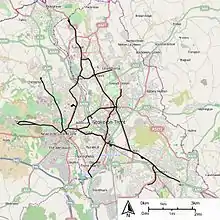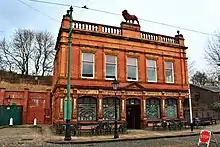Potteries Electric Traction Company
The Potteries Electric Traction Company operated a tramway service in The Potteries between 1899 and 1928.[1]
| Potteries Electric Traction Company | |
|---|---|
 Map of the routes of the Potteries Electric Traction Company | |
| Operation | |
| Locale | The Potteries |
| Open | 16 May 1899 |
| Close | 1928 |
| Status | Closed |
| Infrastructure | |
| Track gauge | 4 ft (1,219 mm) |
| Propulsion system(s) | Electric |
| Depot(s) | see main body for info. |
| Statistics | |
| Route length | 32 miles (51 km) |
| Potteries Electric Traction map Goldenhill - Longton and Silverdale | ||||||||||||||||||||||||||||||||||||||||||||||||||||||||||||||||||||||||||||||||||||||||||||||||||||||||||||||||||||||||||||||||||||||||||||||||||||||||||||||||||||||||||||||||||||||||||||||||||||||||||||||||||||||||||||||||||||||||||||||||||||||||||||||||||||||
|---|---|---|---|---|---|---|---|---|---|---|---|---|---|---|---|---|---|---|---|---|---|---|---|---|---|---|---|---|---|---|---|---|---|---|---|---|---|---|---|---|---|---|---|---|---|---|---|---|---|---|---|---|---|---|---|---|---|---|---|---|---|---|---|---|---|---|---|---|---|---|---|---|---|---|---|---|---|---|---|---|---|---|---|---|---|---|---|---|---|---|---|---|---|---|---|---|---|---|---|---|---|---|---|---|---|---|---|---|---|---|---|---|---|---|---|---|---|---|---|---|---|---|---|---|---|---|---|---|---|---|---|---|---|---|---|---|---|---|---|---|---|---|---|---|---|---|---|---|---|---|---|---|---|---|---|---|---|---|---|---|---|---|---|---|---|---|---|---|---|---|---|---|---|---|---|---|---|---|---|---|---|---|---|---|---|---|---|---|---|---|---|---|---|---|---|---|---|---|---|---|---|---|---|---|---|---|---|---|---|---|---|---|---|---|---|---|---|---|---|---|---|---|---|---|---|---|---|---|---|---|---|---|---|---|---|---|---|---|---|---|---|---|---|---|---|---|---|---|---|---|---|---|---|---|---|---|---|---|---|---|---|---|
| ||||||||||||||||||||||||||||||||||||||||||||||||||||||||||||||||||||||||||||||||||||||||||||||||||||||||||||||||||||||||||||||||||||||||||||||||||||||||||||||||||||||||||||||||||||||||||||||||||||||||||||||||||||||||||||||||||||||||||||||||||||||||||||||||||||||
| Potteries Electric Traction map Chesterton to Trent Vale / Hanford | |||||||||||||||||||||||||||||||||||||||||||||||||||||||||||||||||||||||||||||||||||||||||||||||||||||||||||||||||||||||||||||||||||||||||||||||||
|---|---|---|---|---|---|---|---|---|---|---|---|---|---|---|---|---|---|---|---|---|---|---|---|---|---|---|---|---|---|---|---|---|---|---|---|---|---|---|---|---|---|---|---|---|---|---|---|---|---|---|---|---|---|---|---|---|---|---|---|---|---|---|---|---|---|---|---|---|---|---|---|---|---|---|---|---|---|---|---|---|---|---|---|---|---|---|---|---|---|---|---|---|---|---|---|---|---|---|---|---|---|---|---|---|---|---|---|---|---|---|---|---|---|---|---|---|---|---|---|---|---|---|---|---|---|---|---|---|---|---|---|---|---|---|---|---|---|---|---|---|---|---|---|---|---|
| |||||||||||||||||||||||||||||||||||||||||||||||||||||||||||||||||||||||||||||||||||||||||||||||||||||||||||||||||||||||||||||||||||||||||||||||||
History
British Electric Traction incorporated a new company on 27 June 1898, called the Potteries Electric Traction Company. Its purpose was to extend the existing tramway through the towns of the Potteries. It acquired the North Staffordshire Tramways Company Limited and arranged to take over the Longton Corporation Tramways.
Construction was awarded to Dick, Kerr & Co. and the overhead work was awarded to R. W Blackwell and Company. The coal-fired power station was constructed by Brush Electrical Engineering Company at the depot at Woodhouse Street, Stoke. Later a second station was opened at May Bank.
On 16 May 1899 the first electric trams ran from Stoke to Longton. By 1902, the company had a fleet of 105 trams and carried 14,438,048 passengers. By 1904 the system had expanded to 32 miles of route.
Fleet
- 1-17 Brush single deck cars 1898
- 18-27 Brush single deck trailers 1898
- 28-40 Brush single deck cars 1899
- 41-70 Electric Railway and Tramway Carriage Works 1900.
- 71-85 Midland Railway Carriage and Wagon Company 1900.
- 86-106 Brush 1901 (99, 100 and 106 transferred to Barrow in Furness Tramways 1904/05)
- 99-100 Second-hand cars from Middleton Electric Traction Company
- 107 Works car
- 108 Open railway type car
- 109-112 Parcels trailers
- 113-117 Brush 1906
- 118-119 Second hand cars from Middleton Electric Traction Company
- 120
- 121-123 Three second hand cars 1920 from Sheffield Corporation Tramways (Sheffield 58, 122 and 123)
- 124 Modified iron tip wagon 1922.
- 125 Second-hand car from the Dudley, Stourbridge and District Electric Traction Company
Accidents
Trams were relatively safe, although there were accidents.
In 1923, a runaway tram was destroyed in an accident on Hartshill Bank, the steepest gradient on the system, and 18 passengers were injured.[2]
A year later, a driver was fatally injured in an accident at the Granville level crossings in Cobridge.
Depot
As with all tram systems, the PET Company had a number of tram depots located at the end of each line. PET had depots located at Chesterton, Fenton, Goldenhill, Stoke, Maybank.
Closure
The system closed in 1928.

The Red Lion public house which for years stood outside the tramway depot in Stoke-on-Trent, is now relocated to the National Tramway Museum.
Possible reintroduction
It has been proposed as part of the Transforming Cities Fund that Stoke-on-Trent could get a tramway once again for the first time in 90 years.[3][4]
References
- The Golden Age of Tramways. Published by Taylor and Francis.
- http://www.thisisstaffordshire.co.uk/Fenton-1962-tramlines-dug/story-12540762-detail/story.html
- https://staffslive.co.uk/2018/10/stoke-plans-welcome-trams-back-city/
- https://www.stokesentinel.co.uk/news/trams-stoke-on-trent-plan-2071314